Business and Business Environment: Aldi's Organizational Analysis
VerifiedAdded on 2020/10/05
|14
|4458
|150
Report
AI Summary
This report provides a comprehensive analysis of Aldi's business environment. It begins with an introduction to the business environment and its impact on organizations, then proceeds to examine Aldi's legal structure as a private enterprise, its size, and its scope. The report also explores the relationship between different organizational functions, such as human resources, marketing, and finance, and their links to organizational structure, including flat, matrix, functional, project, market, and product structures. Furthermore, it delves into the positive and negative impacts of the macro environment on business operations and concludes with a SWOT analysis of Aldi, assessing its strengths, weaknesses, opportunities, and threats. The report includes a discussion of other organizations like the Child Support Agency and Oxfam to provide context and comparison.
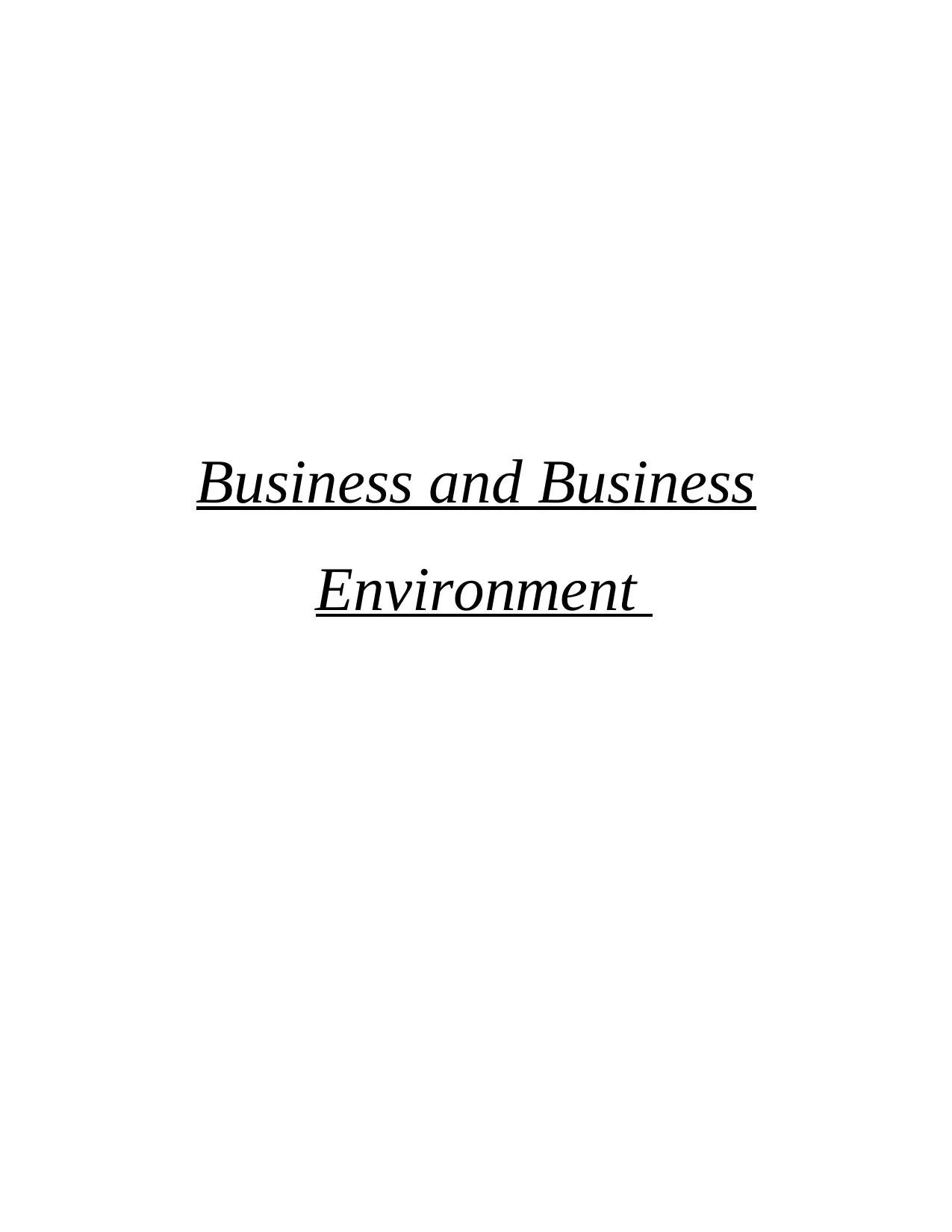
Business and Business
Environment
Environment
Paraphrase This Document
Need a fresh take? Get an instant paraphrase of this document with our AI Paraphraser

Table of Contents
INTRODUCTION:-.........................................................................................................................1
TASK 1............................................................................................................................................1
P1 Various types and purpose of organisation with legal structures......................................1
P2 Size and scope of the organisations...................................................................................2
P3 Relationship between different organisational function and their link with organisational
structure..................................................................................................................................4
TASK 3............................................................................................................................................6
P4 Positive and Negative impact of macro environment of business operations...................6
TASK 4............................................................................................................................................8
P5 Swot analysis:....................................................................................................................8
CONCLUSION:.............................................................................................................................10
REFERENCES................................................................................................................................1
INTRODUCTION:-.........................................................................................................................1
TASK 1............................................................................................................................................1
P1 Various types and purpose of organisation with legal structures......................................1
P2 Size and scope of the organisations...................................................................................2
P3 Relationship between different organisational function and their link with organisational
structure..................................................................................................................................4
TASK 3............................................................................................................................................6
P4 Positive and Negative impact of macro environment of business operations...................6
TASK 4............................................................................................................................................8
P5 Swot analysis:....................................................................................................................8
CONCLUSION:.............................................................................................................................10
REFERENCES................................................................................................................................1
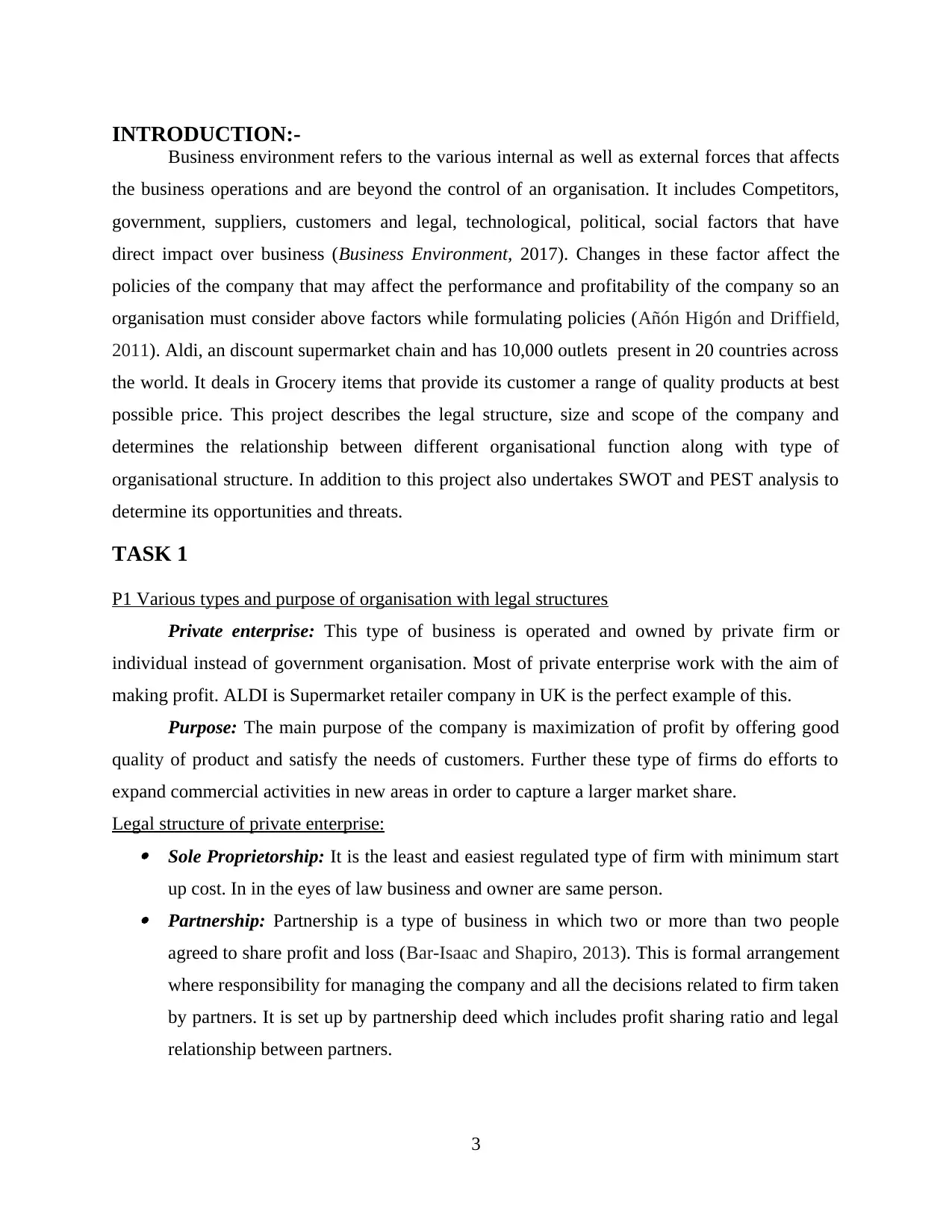
INTRODUCTION:-
Business environment refers to the various internal as well as external forces that affects
the business operations and are beyond the control of an organisation. It includes Competitors,
government, suppliers, customers and legal, technological, political, social factors that have
direct impact over business (Business Environment, 2017). Changes in these factor affect the
policies of the company that may affect the performance and profitability of the company so an
organisation must consider above factors while formulating policies (Añón Higón and Driffield,
2011). Aldi, an discount supermarket chain and has 10,000 outlets present in 20 countries across
the world. It deals in Grocery items that provide its customer a range of quality products at best
possible price. This project describes the legal structure, size and scope of the company and
determines the relationship between different organisational function along with type of
organisational structure. In addition to this project also undertakes SWOT and PEST analysis to
determine its opportunities and threats.
TASK 1
P1 Various types and purpose of organisation with legal structures
Private enterprise: This type of business is operated and owned by private firm or
individual instead of government organisation. Most of private enterprise work with the aim of
making profit. ALDI is Supermarket retailer company in UK is the perfect example of this.
Purpose: The main purpose of the company is maximization of profit by offering good
quality of product and satisfy the needs of customers. Further these type of firms do efforts to
expand commercial activities in new areas in order to capture a larger market share.
Legal structure of private enterprise: Sole Proprietorship: It is the least and easiest regulated type of firm with minimum start
up cost. In in the eyes of law business and owner are same person. Partnership: Partnership is a type of business in which two or more than two people
agreed to share profit and loss (Bar-Isaac and Shapiro, 2013). This is formal arrangement
where responsibility for managing the company and all the decisions related to firm taken
by partners. It is set up by partnership deed which includes profit sharing ratio and legal
relationship between partners.
3
Business environment refers to the various internal as well as external forces that affects
the business operations and are beyond the control of an organisation. It includes Competitors,
government, suppliers, customers and legal, technological, political, social factors that have
direct impact over business (Business Environment, 2017). Changes in these factor affect the
policies of the company that may affect the performance and profitability of the company so an
organisation must consider above factors while formulating policies (Añón Higón and Driffield,
2011). Aldi, an discount supermarket chain and has 10,000 outlets present in 20 countries across
the world. It deals in Grocery items that provide its customer a range of quality products at best
possible price. This project describes the legal structure, size and scope of the company and
determines the relationship between different organisational function along with type of
organisational structure. In addition to this project also undertakes SWOT and PEST analysis to
determine its opportunities and threats.
TASK 1
P1 Various types and purpose of organisation with legal structures
Private enterprise: This type of business is operated and owned by private firm or
individual instead of government organisation. Most of private enterprise work with the aim of
making profit. ALDI is Supermarket retailer company in UK is the perfect example of this.
Purpose: The main purpose of the company is maximization of profit by offering good
quality of product and satisfy the needs of customers. Further these type of firms do efforts to
expand commercial activities in new areas in order to capture a larger market share.
Legal structure of private enterprise: Sole Proprietorship: It is the least and easiest regulated type of firm with minimum start
up cost. In in the eyes of law business and owner are same person. Partnership: Partnership is a type of business in which two or more than two people
agreed to share profit and loss (Bar-Isaac and Shapiro, 2013). This is formal arrangement
where responsibility for managing the company and all the decisions related to firm taken
by partners. It is set up by partnership deed which includes profit sharing ratio and legal
relationship between partners.
3
⊘ This is a preview!⊘
Do you want full access?
Subscribe today to unlock all pages.

Trusted by 1+ million students worldwide
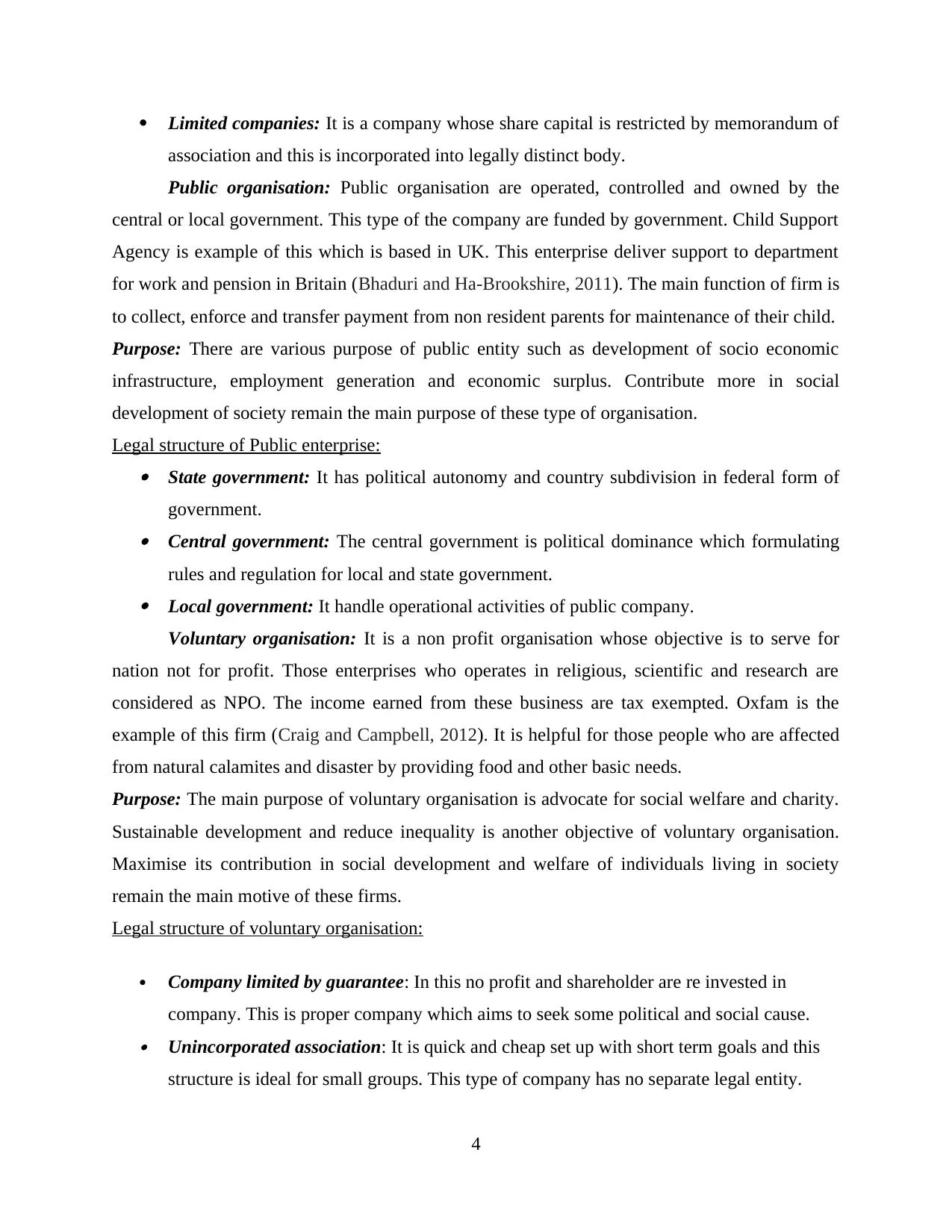
Limited companies: It is a company whose share capital is restricted by memorandum of
association and this is incorporated into legally distinct body.
Public organisation: Public organisation are operated, controlled and owned by the
central or local government. This type of the company are funded by government. Child Support
Agency is example of this which is based in UK. This enterprise deliver support to department
for work and pension in Britain (Bhaduri and Ha-Brookshire, 2011). The main function of firm is
to collect, enforce and transfer payment from non resident parents for maintenance of their child.
Purpose: There are various purpose of public entity such as development of socio economic
infrastructure, employment generation and economic surplus. Contribute more in social
development of society remain the main purpose of these type of organisation.
Legal structure of Public enterprise: State government: It has political autonomy and country subdivision in federal form of
government. Central government: The central government is political dominance which formulating
rules and regulation for local and state government. Local government: It handle operational activities of public company.
Voluntary organisation: It is a non profit organisation whose objective is to serve for
nation not for profit. Those enterprises who operates in religious, scientific and research are
considered as NPO. The income earned from these business are tax exempted. Oxfam is the
example of this firm (Craig and Campbell, 2012). It is helpful for those people who are affected
from natural calamites and disaster by providing food and other basic needs.
Purpose: The main purpose of voluntary organisation is advocate for social welfare and charity.
Sustainable development and reduce inequality is another objective of voluntary organisation.
Maximise its contribution in social development and welfare of individuals living in society
remain the main motive of these firms.
Legal structure of voluntary organisation:
Company limited by guarantee: In this no profit and shareholder are re invested in
company. This is proper company which aims to seek some political and social cause. Unincorporated association: It is quick and cheap set up with short term goals and this
structure is ideal for small groups. This type of company has no separate legal entity.
4
association and this is incorporated into legally distinct body.
Public organisation: Public organisation are operated, controlled and owned by the
central or local government. This type of the company are funded by government. Child Support
Agency is example of this which is based in UK. This enterprise deliver support to department
for work and pension in Britain (Bhaduri and Ha-Brookshire, 2011). The main function of firm is
to collect, enforce and transfer payment from non resident parents for maintenance of their child.
Purpose: There are various purpose of public entity such as development of socio economic
infrastructure, employment generation and economic surplus. Contribute more in social
development of society remain the main purpose of these type of organisation.
Legal structure of Public enterprise: State government: It has political autonomy and country subdivision in federal form of
government. Central government: The central government is political dominance which formulating
rules and regulation for local and state government. Local government: It handle operational activities of public company.
Voluntary organisation: It is a non profit organisation whose objective is to serve for
nation not for profit. Those enterprises who operates in religious, scientific and research are
considered as NPO. The income earned from these business are tax exempted. Oxfam is the
example of this firm (Craig and Campbell, 2012). It is helpful for those people who are affected
from natural calamites and disaster by providing food and other basic needs.
Purpose: The main purpose of voluntary organisation is advocate for social welfare and charity.
Sustainable development and reduce inequality is another objective of voluntary organisation.
Maximise its contribution in social development and welfare of individuals living in society
remain the main motive of these firms.
Legal structure of voluntary organisation:
Company limited by guarantee: In this no profit and shareholder are re invested in
company. This is proper company which aims to seek some political and social cause. Unincorporated association: It is quick and cheap set up with short term goals and this
structure is ideal for small groups. This type of company has no separate legal entity.
4
Paraphrase This Document
Need a fresh take? Get an instant paraphrase of this document with our AI Paraphraser
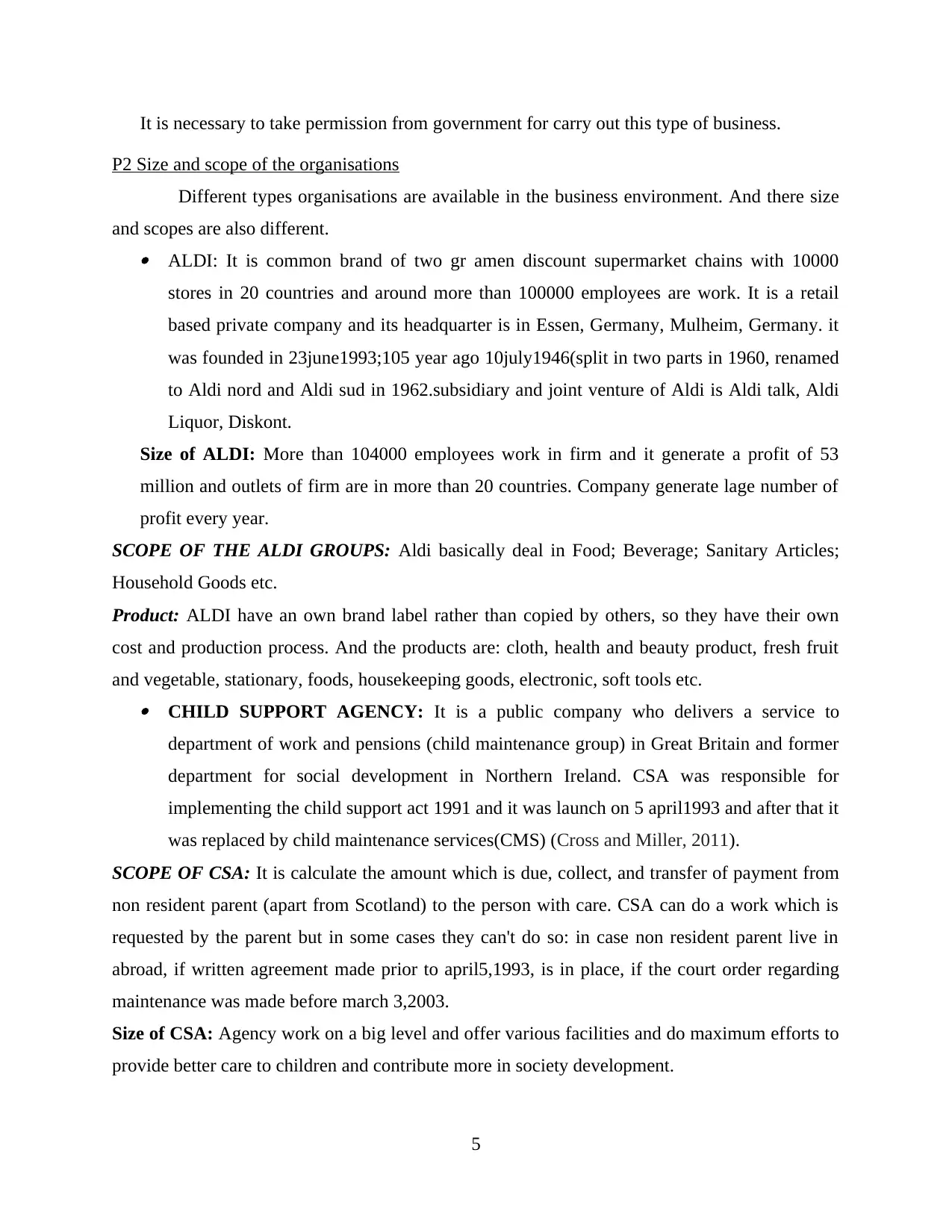
It is necessary to take permission from government for carry out this type of business.
P2 Size and scope of the organisations
Different types organisations are available in the business environment. And there size
and scopes are also different. ALDI: It is common brand of two gr amen discount supermarket chains with 10000
stores in 20 countries and around more than 100000 employees are work. It is a retail
based private company and its headquarter is in Essen, Germany, Mulheim, Germany. it
was founded in 23june1993;105 year ago 10july1946(split in two parts in 1960, renamed
to Aldi nord and Aldi sud in 1962.subsidiary and joint venture of Aldi is Aldi talk, Aldi
Liquor, Diskont.
Size of ALDI: More than 104000 employees work in firm and it generate a profit of 53
million and outlets of firm are in more than 20 countries. Company generate lage number of
profit every year.
SCOPE OF THE ALDI GROUPS: Aldi basically deal in Food; Beverage; Sanitary Articles;
Household Goods etc.
Product: ALDI have an own brand label rather than copied by others, so they have their own
cost and production process. And the products are: cloth, health and beauty product, fresh fruit
and vegetable, stationary, foods, housekeeping goods, electronic, soft tools etc. CHILD SUPPORT AGENCY: It is a public company who delivers a service to
department of work and pensions (child maintenance group) in Great Britain and former
department for social development in Northern Ireland. CSA was responsible for
implementing the child support act 1991 and it was launch on 5 april1993 and after that it
was replaced by child maintenance services(CMS) (Cross and Miller, 2011).
SCOPE OF CSA: It is calculate the amount which is due, collect, and transfer of payment from
non resident parent (apart from Scotland) to the person with care. CSA can do a work which is
requested by the parent but in some cases they can't do so: in case non resident parent live in
abroad, if written agreement made prior to april5,1993, is in place, if the court order regarding
maintenance was made before march 3,2003.
Size of CSA: Agency work on a big level and offer various facilities and do maximum efforts to
provide better care to children and contribute more in society development.
5
P2 Size and scope of the organisations
Different types organisations are available in the business environment. And there size
and scopes are also different. ALDI: It is common brand of two gr amen discount supermarket chains with 10000
stores in 20 countries and around more than 100000 employees are work. It is a retail
based private company and its headquarter is in Essen, Germany, Mulheim, Germany. it
was founded in 23june1993;105 year ago 10july1946(split in two parts in 1960, renamed
to Aldi nord and Aldi sud in 1962.subsidiary and joint venture of Aldi is Aldi talk, Aldi
Liquor, Diskont.
Size of ALDI: More than 104000 employees work in firm and it generate a profit of 53
million and outlets of firm are in more than 20 countries. Company generate lage number of
profit every year.
SCOPE OF THE ALDI GROUPS: Aldi basically deal in Food; Beverage; Sanitary Articles;
Household Goods etc.
Product: ALDI have an own brand label rather than copied by others, so they have their own
cost and production process. And the products are: cloth, health and beauty product, fresh fruit
and vegetable, stationary, foods, housekeeping goods, electronic, soft tools etc. CHILD SUPPORT AGENCY: It is a public company who delivers a service to
department of work and pensions (child maintenance group) in Great Britain and former
department for social development in Northern Ireland. CSA was responsible for
implementing the child support act 1991 and it was launch on 5 april1993 and after that it
was replaced by child maintenance services(CMS) (Cross and Miller, 2011).
SCOPE OF CSA: It is calculate the amount which is due, collect, and transfer of payment from
non resident parent (apart from Scotland) to the person with care. CSA can do a work which is
requested by the parent but in some cases they can't do so: in case non resident parent live in
abroad, if written agreement made prior to april5,1993, is in place, if the court order regarding
maintenance was made before march 3,2003.
Size of CSA: Agency work on a big level and offer various facilities and do maximum efforts to
provide better care to children and contribute more in society development.
5
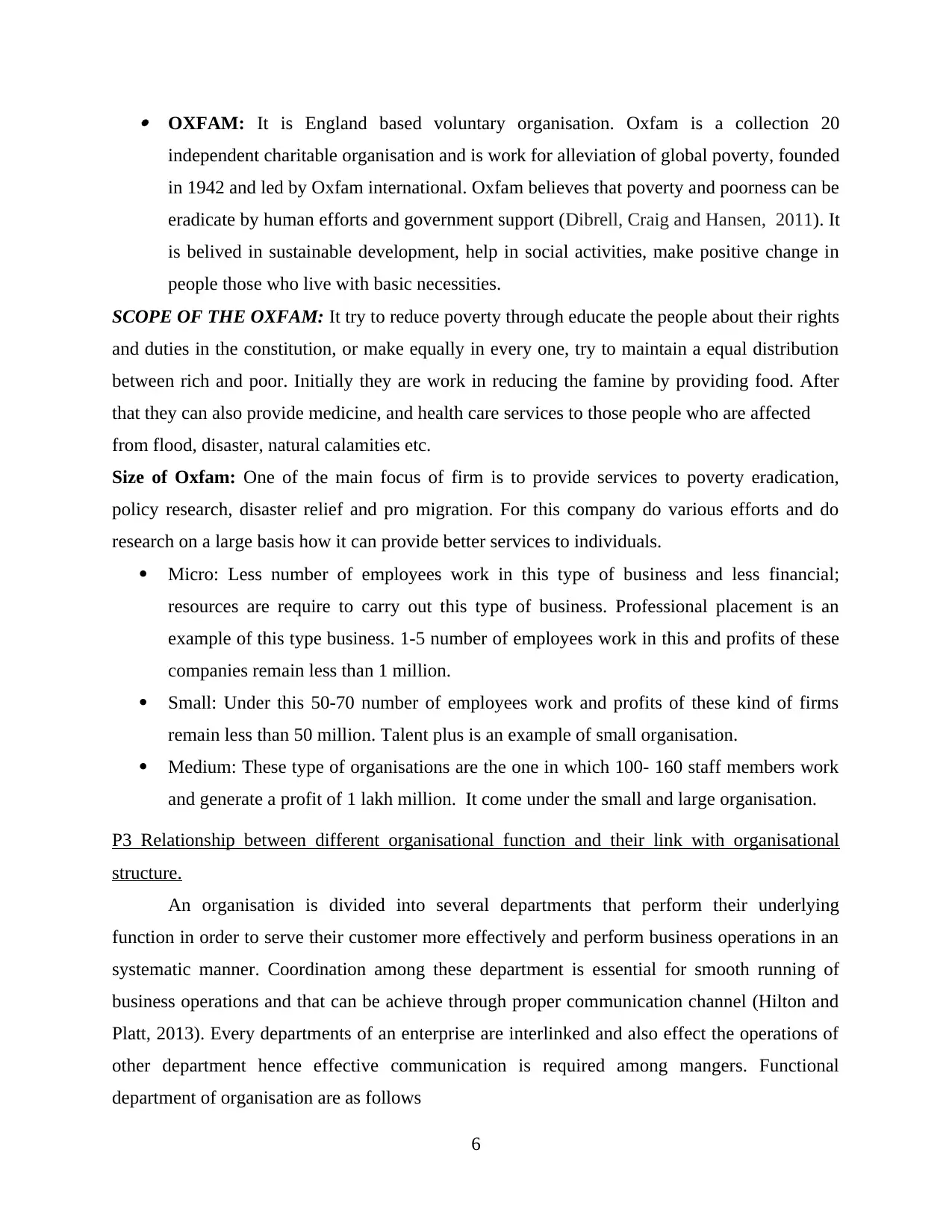
OXFAM: It is England based voluntary organisation. Oxfam is a collection 20
independent charitable organisation and is work for alleviation of global poverty, founded
in 1942 and led by Oxfam international. Oxfam believes that poverty and poorness can be
eradicate by human efforts and government support (Dibrell, Craig and Hansen, 2011). It
is belived in sustainable development, help in social activities, make positive change in
people those who live with basic necessities.
SCOPE OF THE OXFAM: It try to reduce poverty through educate the people about their rights
and duties in the constitution, or make equally in every one, try to maintain a equal distribution
between rich and poor. Initially they are work in reducing the famine by providing food. After
that they can also provide medicine, and health care services to those people who are affected
from flood, disaster, natural calamities etc.
Size of Oxfam: One of the main focus of firm is to provide services to poverty eradication,
policy research, disaster relief and pro migration. For this company do various efforts and do
research on a large basis how it can provide better services to individuals.
Micro: Less number of employees work in this type of business and less financial;
resources are require to carry out this type of business. Professional placement is an
example of this type business. 1-5 number of employees work in this and profits of these
companies remain less than 1 million.
Small: Under this 50-70 number of employees work and profits of these kind of firms
remain less than 50 million. Talent plus is an example of small organisation.
Medium: These type of organisations are the one in which 100- 160 staff members work
and generate a profit of 1 lakh million. It come under the small and large organisation.
P3 Relationship between different organisational function and their link with organisational
structure.
An organisation is divided into several departments that perform their underlying
function in order to serve their customer more effectively and perform business operations in an
systematic manner. Coordination among these department is essential for smooth running of
business operations and that can be achieve through proper communication channel (Hilton and
Platt, 2013). Every departments of an enterprise are interlinked and also effect the operations of
other department hence effective communication is required among mangers. Functional
department of organisation are as follows
6
independent charitable organisation and is work for alleviation of global poverty, founded
in 1942 and led by Oxfam international. Oxfam believes that poverty and poorness can be
eradicate by human efforts and government support (Dibrell, Craig and Hansen, 2011). It
is belived in sustainable development, help in social activities, make positive change in
people those who live with basic necessities.
SCOPE OF THE OXFAM: It try to reduce poverty through educate the people about their rights
and duties in the constitution, or make equally in every one, try to maintain a equal distribution
between rich and poor. Initially they are work in reducing the famine by providing food. After
that they can also provide medicine, and health care services to those people who are affected
from flood, disaster, natural calamities etc.
Size of Oxfam: One of the main focus of firm is to provide services to poverty eradication,
policy research, disaster relief and pro migration. For this company do various efforts and do
research on a large basis how it can provide better services to individuals.
Micro: Less number of employees work in this type of business and less financial;
resources are require to carry out this type of business. Professional placement is an
example of this type business. 1-5 number of employees work in this and profits of these
companies remain less than 1 million.
Small: Under this 50-70 number of employees work and profits of these kind of firms
remain less than 50 million. Talent plus is an example of small organisation.
Medium: These type of organisations are the one in which 100- 160 staff members work
and generate a profit of 1 lakh million. It come under the small and large organisation.
P3 Relationship between different organisational function and their link with organisational
structure.
An organisation is divided into several departments that perform their underlying
function in order to serve their customer more effectively and perform business operations in an
systematic manner. Coordination among these department is essential for smooth running of
business operations and that can be achieve through proper communication channel (Hilton and
Platt, 2013). Every departments of an enterprise are interlinked and also effect the operations of
other department hence effective communication is required among mangers. Functional
department of organisation are as follows
6
⊘ This is a preview!⊘
Do you want full access?
Subscribe today to unlock all pages.

Trusted by 1+ million students worldwide
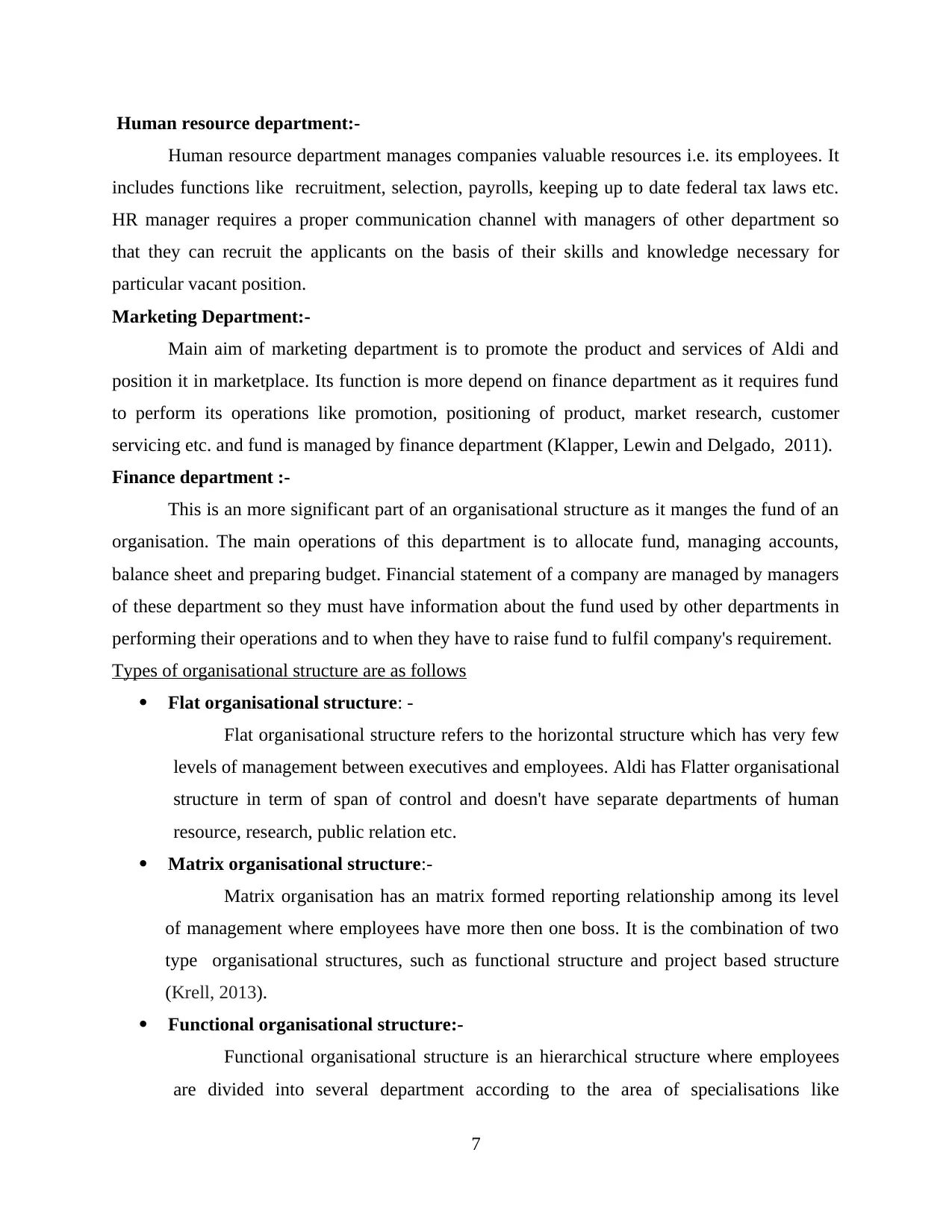
Human resource department:-
Human resource department manages companies valuable resources i.e. its employees. It
includes functions like recruitment, selection, payrolls, keeping up to date federal tax laws etc.
HR manager requires a proper communication channel with managers of other department so
that they can recruit the applicants on the basis of their skills and knowledge necessary for
particular vacant position.
Marketing Department:-
Main aim of marketing department is to promote the product and services of Aldi and
position it in marketplace. Its function is more depend on finance department as it requires fund
to perform its operations like promotion, positioning of product, market research, customer
servicing etc. and fund is managed by finance department (Klapper, Lewin and Delgado, 2011).
Finance department :-
This is an more significant part of an organisational structure as it manges the fund of an
organisation. The main operations of this department is to allocate fund, managing accounts,
balance sheet and preparing budget. Financial statement of a company are managed by managers
of these department so they must have information about the fund used by other departments in
performing their operations and to when they have to raise fund to fulfil company's requirement.
Types of organisational structure are as follows
Flat organisational structure: -
Flat organisational structure refers to the horizontal structure which has very few
levels of management between executives and employees. Aldi has Flatter organisational
structure in term of span of control and doesn't have separate departments of human
resource, research, public relation etc.
Matrix organisational structure:-
Matrix organisation has an matrix formed reporting relationship among its level
of management where employees have more then one boss. It is the combination of two
type organisational structures, such as functional structure and project based structure
(Krell, 2013).
Functional organisational structure:-
Functional organisational structure is an hierarchical structure where employees
are divided into several department according to the area of specialisations like
7
Human resource department manages companies valuable resources i.e. its employees. It
includes functions like recruitment, selection, payrolls, keeping up to date federal tax laws etc.
HR manager requires a proper communication channel with managers of other department so
that they can recruit the applicants on the basis of their skills and knowledge necessary for
particular vacant position.
Marketing Department:-
Main aim of marketing department is to promote the product and services of Aldi and
position it in marketplace. Its function is more depend on finance department as it requires fund
to perform its operations like promotion, positioning of product, market research, customer
servicing etc. and fund is managed by finance department (Klapper, Lewin and Delgado, 2011).
Finance department :-
This is an more significant part of an organisational structure as it manges the fund of an
organisation. The main operations of this department is to allocate fund, managing accounts,
balance sheet and preparing budget. Financial statement of a company are managed by managers
of these department so they must have information about the fund used by other departments in
performing their operations and to when they have to raise fund to fulfil company's requirement.
Types of organisational structure are as follows
Flat organisational structure: -
Flat organisational structure refers to the horizontal structure which has very few
levels of management between executives and employees. Aldi has Flatter organisational
structure in term of span of control and doesn't have separate departments of human
resource, research, public relation etc.
Matrix organisational structure:-
Matrix organisation has an matrix formed reporting relationship among its level
of management where employees have more then one boss. It is the combination of two
type organisational structures, such as functional structure and project based structure
(Krell, 2013).
Functional organisational structure:-
Functional organisational structure is an hierarchical structure where employees
are divided into several department according to the area of specialisations like
7
Paraphrase This Document
Need a fresh take? Get an instant paraphrase of this document with our AI Paraphraser
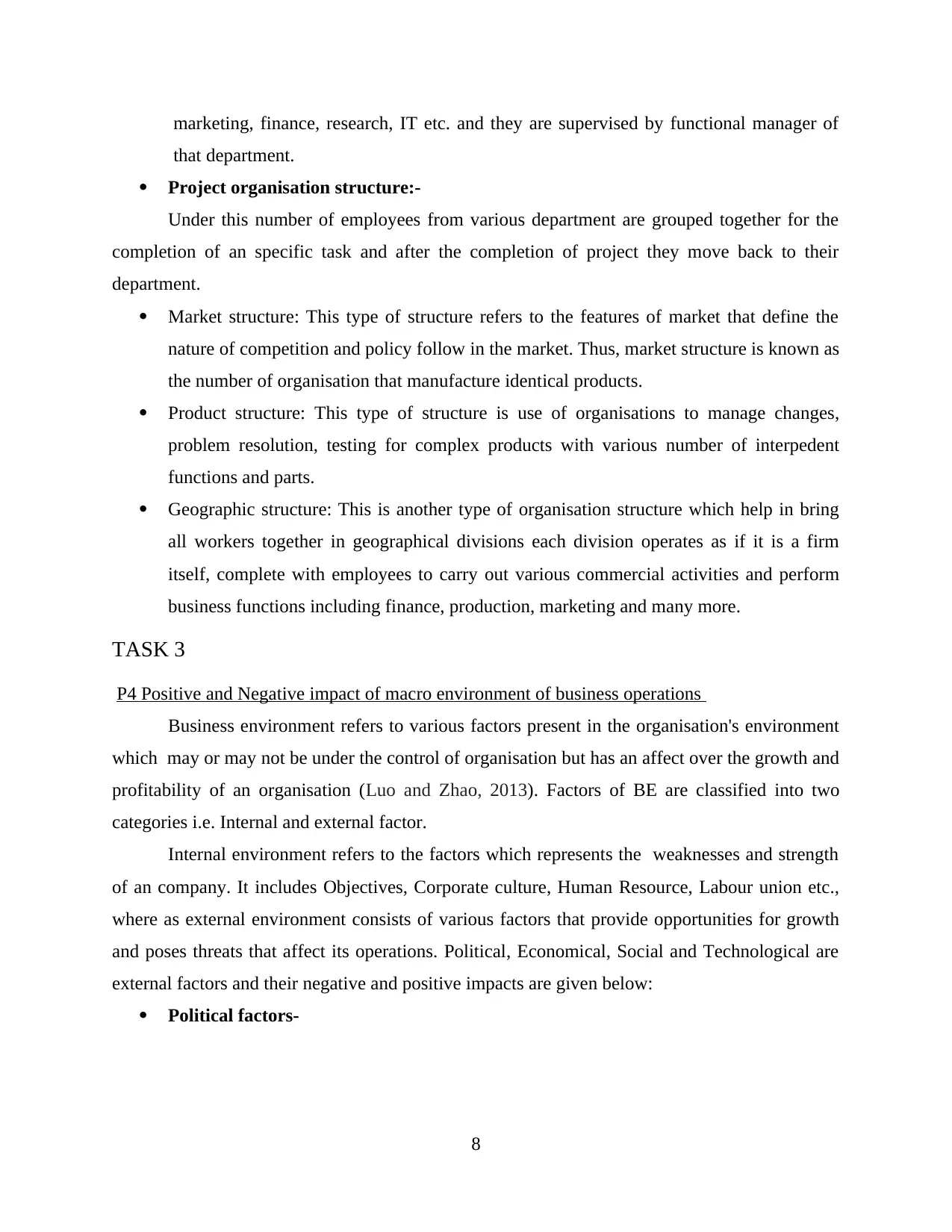
marketing, finance, research, IT etc. and they are supervised by functional manager of
that department.
Project organisation structure:-
Under this number of employees from various department are grouped together for the
completion of an specific task and after the completion of project they move back to their
department.
Market structure: This type of structure refers to the features of market that define the
nature of competition and policy follow in the market. Thus, market structure is known as
the number of organisation that manufacture identical products.
Product structure: This type of structure is use of organisations to manage changes,
problem resolution, testing for complex products with various number of interpedent
functions and parts.
Geographic structure: This is another type of organisation structure which help in bring
all workers together in geographical divisions each division operates as if it is a firm
itself, complete with employees to carry out various commercial activities and perform
business functions including finance, production, marketing and many more.
TASK 3
P4 Positive and Negative impact of macro environment of business operations
Business environment refers to various factors present in the organisation's environment
which may or may not be under the control of organisation but has an affect over the growth and
profitability of an organisation (Luo and Zhao, 2013). Factors of BE are classified into two
categories i.e. Internal and external factor.
Internal environment refers to the factors which represents the weaknesses and strength
of an company. It includes Objectives, Corporate culture, Human Resource, Labour union etc.,
where as external environment consists of various factors that provide opportunities for growth
and poses threats that affect its operations. Political, Economical, Social and Technological are
external factors and their negative and positive impacts are given below:
Political factors-
8
that department.
Project organisation structure:-
Under this number of employees from various department are grouped together for the
completion of an specific task and after the completion of project they move back to their
department.
Market structure: This type of structure refers to the features of market that define the
nature of competition and policy follow in the market. Thus, market structure is known as
the number of organisation that manufacture identical products.
Product structure: This type of structure is use of organisations to manage changes,
problem resolution, testing for complex products with various number of interpedent
functions and parts.
Geographic structure: This is another type of organisation structure which help in bring
all workers together in geographical divisions each division operates as if it is a firm
itself, complete with employees to carry out various commercial activities and perform
business functions including finance, production, marketing and many more.
TASK 3
P4 Positive and Negative impact of macro environment of business operations
Business environment refers to various factors present in the organisation's environment
which may or may not be under the control of organisation but has an affect over the growth and
profitability of an organisation (Luo and Zhao, 2013). Factors of BE are classified into two
categories i.e. Internal and external factor.
Internal environment refers to the factors which represents the weaknesses and strength
of an company. It includes Objectives, Corporate culture, Human Resource, Labour union etc.,
where as external environment consists of various factors that provide opportunities for growth
and poses threats that affect its operations. Political, Economical, Social and Technological are
external factors and their negative and positive impacts are given below:
Political factors-
8

Political factors refers to changes that are bought by government in laws and policies that
may affect business operations. It includes factors like trading policies, war, terrorism, conflict
among countries.
Positive impact:- For an positive result Aldi must identify the political stability of nation and
plan strategies accordingly.
Negative impact:- With the change in government of UK in 2015 results in modification of
policies of the company.
Economical factors-
These factors are related to the economical structure of an country that may affect
business operations (Prajogo, 2016). It consists of inflation and deflation policies, exchange rate
fluctuation, economical trends etc.
Positive impact:- As in may 2017 there is increase in inflation rate in market from 2.6% to 2.9%
this is an favourable change for Aldi as customer prefer cheaper product and it is Discount
supermarket.
Negative impact:- When inflation rate increases it results in decrease in sale and profit of the
company.
Social factors-
This includes factors like attitude, cultural aspects, taste & preferences of customer.
These attributes affect the choice of customer related to purchasing of product and services to a
large extent and the way business operates.
Positive impact: - Aldi provides product according to the need of customer along with discount
that help it in attracting more customers.
Negative impact: - Competitors like Tesco, Sainsbury are offering 24 hour opening services this
strategy affect market share of Aldi and results in reduction of its market share (Savrul, Incekara
and Sener, 2014).
Technological factors-
It generally includes factor that leads to change in technology local as well as on global
scale. Factors included are technological up gradation, competitor's technology etc.
Positive factors: - To get positive result Aldi need to update its technology which reduces time
along with cost in operations.
9
may affect business operations. It includes factors like trading policies, war, terrorism, conflict
among countries.
Positive impact:- For an positive result Aldi must identify the political stability of nation and
plan strategies accordingly.
Negative impact:- With the change in government of UK in 2015 results in modification of
policies of the company.
Economical factors-
These factors are related to the economical structure of an country that may affect
business operations (Prajogo, 2016). It consists of inflation and deflation policies, exchange rate
fluctuation, economical trends etc.
Positive impact:- As in may 2017 there is increase in inflation rate in market from 2.6% to 2.9%
this is an favourable change for Aldi as customer prefer cheaper product and it is Discount
supermarket.
Negative impact:- When inflation rate increases it results in decrease in sale and profit of the
company.
Social factors-
This includes factors like attitude, cultural aspects, taste & preferences of customer.
These attributes affect the choice of customer related to purchasing of product and services to a
large extent and the way business operates.
Positive impact: - Aldi provides product according to the need of customer along with discount
that help it in attracting more customers.
Negative impact: - Competitors like Tesco, Sainsbury are offering 24 hour opening services this
strategy affect market share of Aldi and results in reduction of its market share (Savrul, Incekara
and Sener, 2014).
Technological factors-
It generally includes factor that leads to change in technology local as well as on global
scale. Factors included are technological up gradation, competitor's technology etc.
Positive factors: - To get positive result Aldi need to update its technology which reduces time
along with cost in operations.
9
⊘ This is a preview!⊘
Do you want full access?
Subscribe today to unlock all pages.

Trusted by 1+ million students worldwide
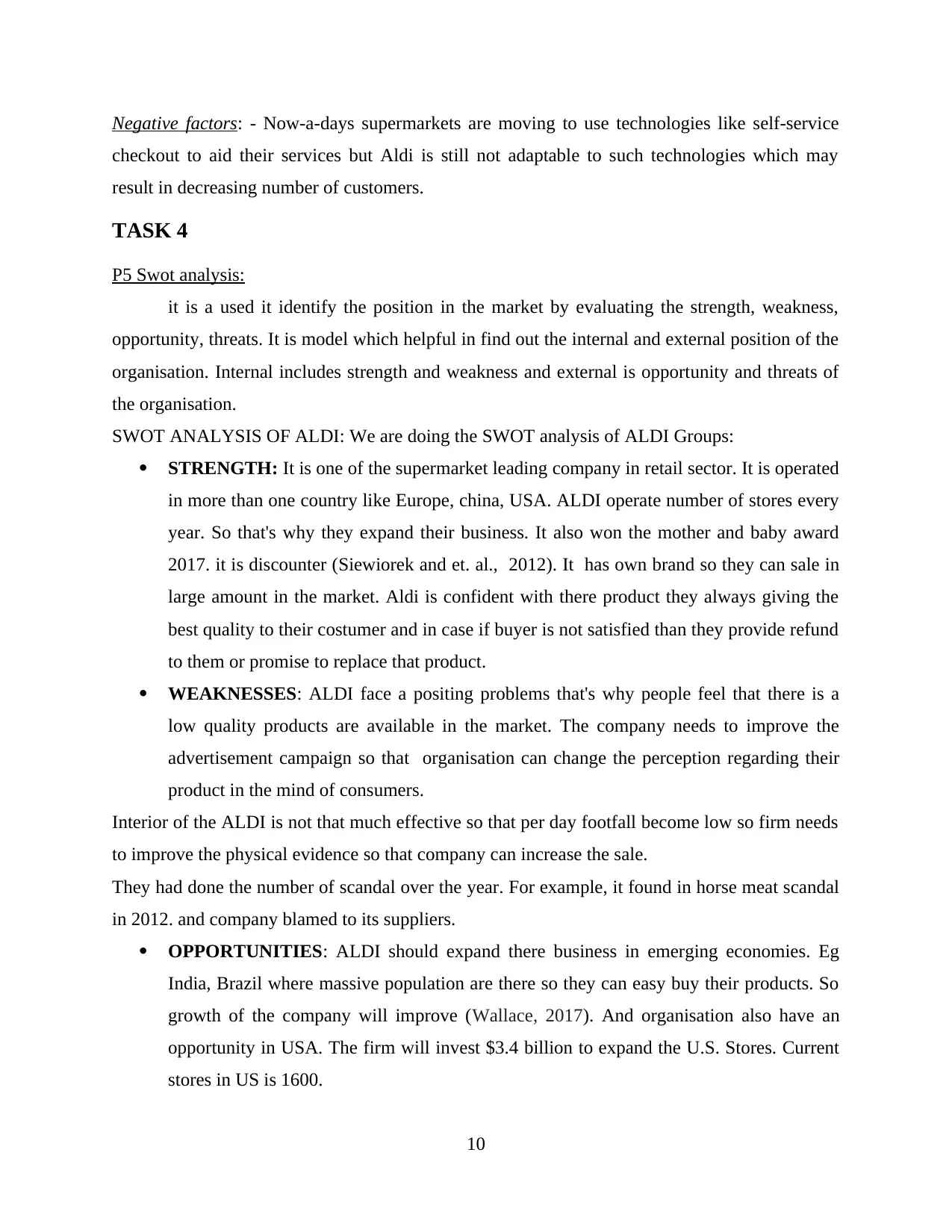
Negative factors: - Now-a-days supermarkets are moving to use technologies like self-service
checkout to aid their services but Aldi is still not adaptable to such technologies which may
result in decreasing number of customers.
TASK 4
P5 Swot analysis:
it is a used it identify the position in the market by evaluating the strength, weakness,
opportunity, threats. It is model which helpful in find out the internal and external position of the
organisation. Internal includes strength and weakness and external is opportunity and threats of
the organisation.
SWOT ANALYSIS OF ALDI: We are doing the SWOT analysis of ALDI Groups:
STRENGTH: It is one of the supermarket leading company in retail sector. It is operated
in more than one country like Europe, china, USA. ALDI operate number of stores every
year. So that's why they expand their business. It also won the mother and baby award
2017. it is discounter (Siewiorek and et. al., 2012). It has own brand so they can sale in
large amount in the market. Aldi is confident with there product they always giving the
best quality to their costumer and in case if buyer is not satisfied than they provide refund
to them or promise to replace that product.
WEAKNESSES: ALDI face a positing problems that's why people feel that there is a
low quality products are available in the market. The company needs to improve the
advertisement campaign so that organisation can change the perception regarding their
product in the mind of consumers.
Interior of the ALDI is not that much effective so that per day footfall become low so firm needs
to improve the physical evidence so that company can increase the sale.
They had done the number of scandal over the year. For example, it found in horse meat scandal
in 2012. and company blamed to its suppliers.
OPPORTUNITIES: ALDI should expand there business in emerging economies. Eg
India, Brazil where massive population are there so they can easy buy their products. So
growth of the company will improve (Wallace, 2017). And organisation also have an
opportunity in USA. The firm will invest $3.4 billion to expand the U.S. Stores. Current
stores in US is 1600.
10
checkout to aid their services but Aldi is still not adaptable to such technologies which may
result in decreasing number of customers.
TASK 4
P5 Swot analysis:
it is a used it identify the position in the market by evaluating the strength, weakness,
opportunity, threats. It is model which helpful in find out the internal and external position of the
organisation. Internal includes strength and weakness and external is opportunity and threats of
the organisation.
SWOT ANALYSIS OF ALDI: We are doing the SWOT analysis of ALDI Groups:
STRENGTH: It is one of the supermarket leading company in retail sector. It is operated
in more than one country like Europe, china, USA. ALDI operate number of stores every
year. So that's why they expand their business. It also won the mother and baby award
2017. it is discounter (Siewiorek and et. al., 2012). It has own brand so they can sale in
large amount in the market. Aldi is confident with there product they always giving the
best quality to their costumer and in case if buyer is not satisfied than they provide refund
to them or promise to replace that product.
WEAKNESSES: ALDI face a positing problems that's why people feel that there is a
low quality products are available in the market. The company needs to improve the
advertisement campaign so that organisation can change the perception regarding their
product in the mind of consumers.
Interior of the ALDI is not that much effective so that per day footfall become low so firm needs
to improve the physical evidence so that company can increase the sale.
They had done the number of scandal over the year. For example, it found in horse meat scandal
in 2012. and company blamed to its suppliers.
OPPORTUNITIES: ALDI should expand there business in emerging economies. Eg
India, Brazil where massive population are there so they can easy buy their products. So
growth of the company will improve (Wallace, 2017). And organisation also have an
opportunity in USA. The firm will invest $3.4 billion to expand the U.S. Stores. Current
stores in US is 1600.
10
Paraphrase This Document
Need a fresh take? Get an instant paraphrase of this document with our AI Paraphraser
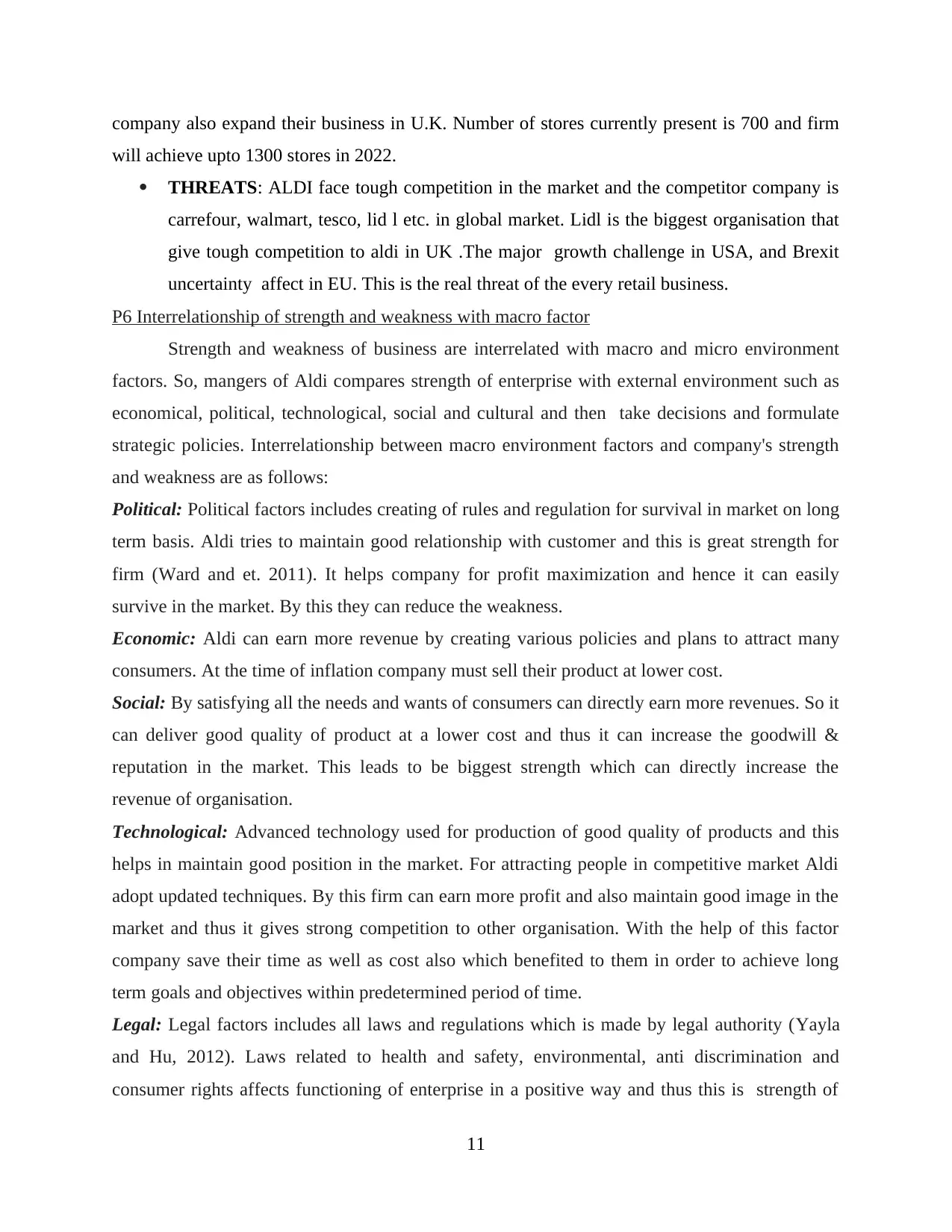
company also expand their business in U.K. Number of stores currently present is 700 and firm
will achieve upto 1300 stores in 2022.
THREATS: ALDI face tough competition in the market and the competitor company is
carrefour, walmart, tesco, lid l etc. in global market. Lidl is the biggest organisation that
give tough competition to aldi in UK .The major growth challenge in USA, and Brexit
uncertainty affect in EU. This is the real threat of the every retail business.
P6 Interrelationship of strength and weakness with macro factor
Strength and weakness of business are interrelated with macro and micro environment
factors. So, mangers of Aldi compares strength of enterprise with external environment such as
economical, political, technological, social and cultural and then take decisions and formulate
strategic policies. Interrelationship between macro environment factors and company's strength
and weakness are as follows:
Political: Political factors includes creating of rules and regulation for survival in market on long
term basis. Aldi tries to maintain good relationship with customer and this is great strength for
firm (Ward and et. 2011). It helps company for profit maximization and hence it can easily
survive in the market. By this they can reduce the weakness.
Economic: Aldi can earn more revenue by creating various policies and plans to attract many
consumers. At the time of inflation company must sell their product at lower cost.
Social: By satisfying all the needs and wants of consumers can directly earn more revenues. So it
can deliver good quality of product at a lower cost and thus it can increase the goodwill &
reputation in the market. This leads to be biggest strength which can directly increase the
revenue of organisation.
Technological: Advanced technology used for production of good quality of products and this
helps in maintain good position in the market. For attracting people in competitive market Aldi
adopt updated techniques. By this firm can earn more profit and also maintain good image in the
market and thus it gives strong competition to other organisation. With the help of this factor
company save their time as well as cost also which benefited to them in order to achieve long
term goals and objectives within predetermined period of time.
Legal: Legal factors includes all laws and regulations which is made by legal authority (Yayla
and Hu, 2012). Laws related to health and safety, environmental, anti discrimination and
consumer rights affects functioning of enterprise in a positive way and thus this is strength of
11
will achieve upto 1300 stores in 2022.
THREATS: ALDI face tough competition in the market and the competitor company is
carrefour, walmart, tesco, lid l etc. in global market. Lidl is the biggest organisation that
give tough competition to aldi in UK .The major growth challenge in USA, and Brexit
uncertainty affect in EU. This is the real threat of the every retail business.
P6 Interrelationship of strength and weakness with macro factor
Strength and weakness of business are interrelated with macro and micro environment
factors. So, mangers of Aldi compares strength of enterprise with external environment such as
economical, political, technological, social and cultural and then take decisions and formulate
strategic policies. Interrelationship between macro environment factors and company's strength
and weakness are as follows:
Political: Political factors includes creating of rules and regulation for survival in market on long
term basis. Aldi tries to maintain good relationship with customer and this is great strength for
firm (Ward and et. 2011). It helps company for profit maximization and hence it can easily
survive in the market. By this they can reduce the weakness.
Economic: Aldi can earn more revenue by creating various policies and plans to attract many
consumers. At the time of inflation company must sell their product at lower cost.
Social: By satisfying all the needs and wants of consumers can directly earn more revenues. So it
can deliver good quality of product at a lower cost and thus it can increase the goodwill &
reputation in the market. This leads to be biggest strength which can directly increase the
revenue of organisation.
Technological: Advanced technology used for production of good quality of products and this
helps in maintain good position in the market. For attracting people in competitive market Aldi
adopt updated techniques. By this firm can earn more profit and also maintain good image in the
market and thus it gives strong competition to other organisation. With the help of this factor
company save their time as well as cost also which benefited to them in order to achieve long
term goals and objectives within predetermined period of time.
Legal: Legal factors includes all laws and regulations which is made by legal authority (Yayla
and Hu, 2012). Laws related to health and safety, environmental, anti discrimination and
consumer rights affects functioning of enterprise in a positive way and thus this is strength of
11
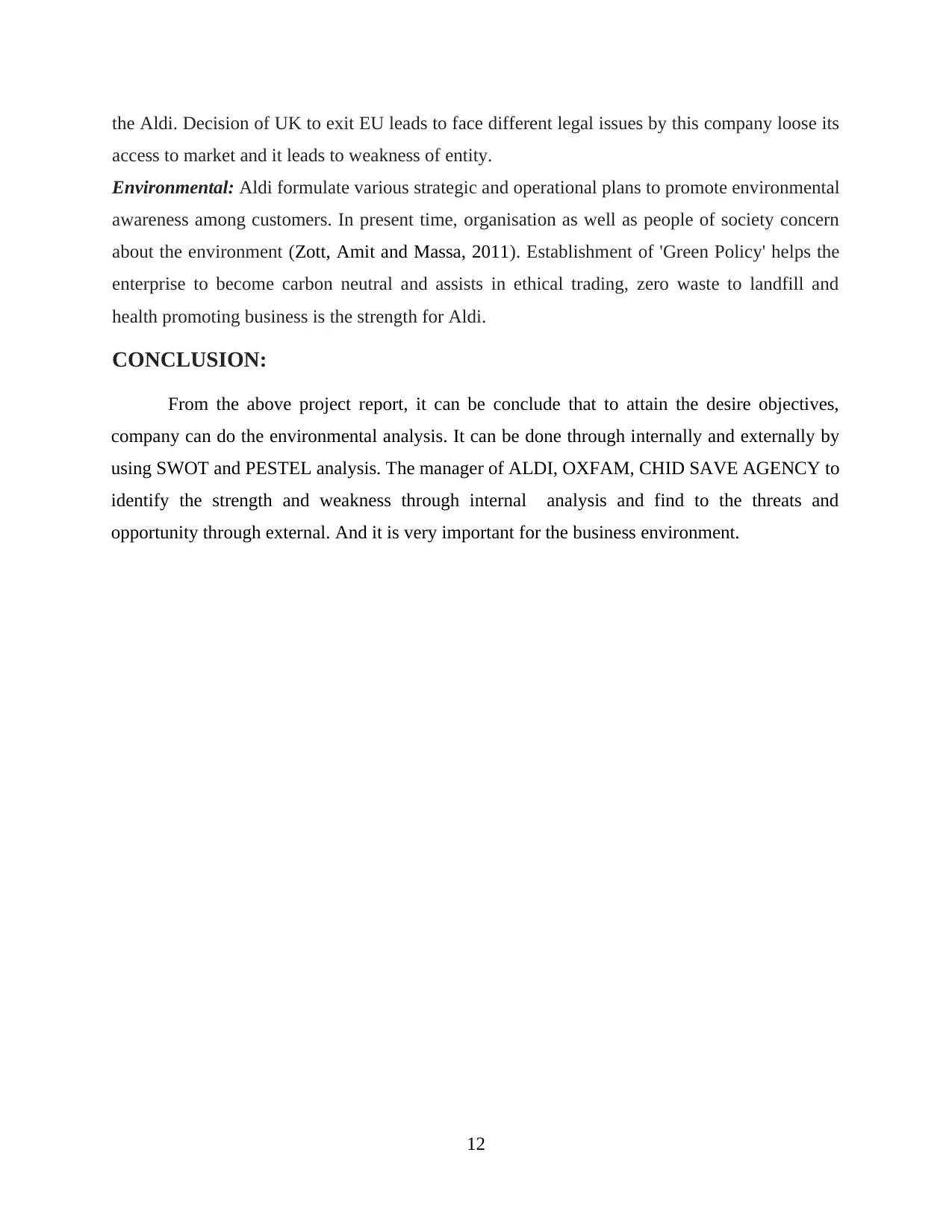
the Aldi. Decision of UK to exit EU leads to face different legal issues by this company loose its
access to market and it leads to weakness of entity.
Environmental: Aldi formulate various strategic and operational plans to promote environmental
awareness among customers. In present time, organisation as well as people of society concern
about the environment (Zott, Amit and Massa, 2011). Establishment of 'Green Policy' helps the
enterprise to become carbon neutral and assists in ethical trading, zero waste to landfill and
health promoting business is the strength for Aldi.
CONCLUSION:
From the above project report, it can be conclude that to attain the desire objectives,
company can do the environmental analysis. It can be done through internally and externally by
using SWOT and PESTEL analysis. The manager of ALDI, OXFAM, CHID SAVE AGENCY to
identify the strength and weakness through internal analysis and find to the threats and
opportunity through external. And it is very important for the business environment.
12
access to market and it leads to weakness of entity.
Environmental: Aldi formulate various strategic and operational plans to promote environmental
awareness among customers. In present time, organisation as well as people of society concern
about the environment (Zott, Amit and Massa, 2011). Establishment of 'Green Policy' helps the
enterprise to become carbon neutral and assists in ethical trading, zero waste to landfill and
health promoting business is the strength for Aldi.
CONCLUSION:
From the above project report, it can be conclude that to attain the desire objectives,
company can do the environmental analysis. It can be done through internally and externally by
using SWOT and PESTEL analysis. The manager of ALDI, OXFAM, CHID SAVE AGENCY to
identify the strength and weakness through internal analysis and find to the threats and
opportunity through external. And it is very important for the business environment.
12
⊘ This is a preview!⊘
Do you want full access?
Subscribe today to unlock all pages.

Trusted by 1+ million students worldwide
1 out of 14
Related Documents
Your All-in-One AI-Powered Toolkit for Academic Success.
+13062052269
info@desklib.com
Available 24*7 on WhatsApp / Email
![[object Object]](/_next/static/media/star-bottom.7253800d.svg)
Unlock your academic potential
Copyright © 2020–2025 A2Z Services. All Rights Reserved. Developed and managed by ZUCOL.





